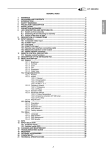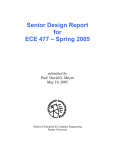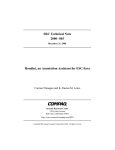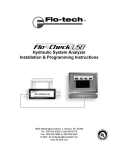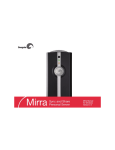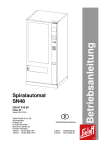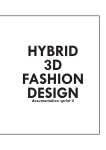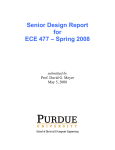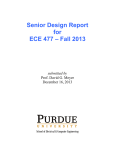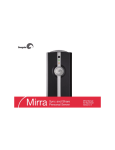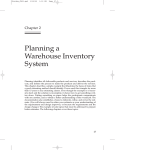Download Senior Design Report for ECE 477 – Fall 2006
Transcript
Senior Design Report for ECE 477 – Fall 2006 submitted by Prof. David G. Meyer December 19, 2006 School of Electrical & Computer Engineering ECE 477 Senior Design Report 12/19/2006 Contents Course Description ……………………………………………………………………………. 1 Course Staff ……………………………………………..……………………………………. 1 Lecture Schedule / Course Calendar ………..………………………………………………… 2 Design Project Specifications / Requirements ……………………………………………..… 4 Design Project Milestones …………………………………………….………………..……. 5 Course Outcomes and Assessment Procedures ……………..……………………………….. 6 Course Grade Determination ………………………………………………………………… 7 Course Assessment Report …………………………………………………………………. 8 Appendix A: Senior Design Reports -ii- ECE 477 12/19/2006 Senior Design Report Course Description Digital Systems Senior Design Project (ECE 477) is a structured approach to the development and integration of embedded microcontroller hardware and software that provides senior-level students with significant design experience applying microcontrollers to a wide range of embedded systems (e.g., instrumentation, process control, telecommunications, intelligent devices, etc.). The primary objective is to provide practical experience developing integrated hardware and software for embedded microcontroller systems in an environment that models one which students will most likely encounter in industry. One of the unique features of this course is that each team gets to choose their own specific project (subject to some general constraints) and define specific success criteria germane to that project. In general, this approach to senior design provides students with a sense of project ownership as well as heightened motivation to achieve functionality. Course web site: http://shay.ecn.purdue.edu/~dsml/ece477 Course Staff Name Prof. David Meyer Dr. Mark Johnson Brian Moerdyk David Jones Title / Role Faculty / Project Advisor Faculty / Project Advisor Teaching Assistant / Project Consultant Volunteer Graduate Project Consultant -1- E-mail Address [email protected] [email protected] [email protected] [email protected] ECE 477 Senior Design Report Lecture Schedule / Course Calendar -2- 12/19/2006 ECE 477 Senior Design Report 12/19/2006 Design Project Specifications / Requirements Work on the design project is to be completed in teams of four students. The design project topic is flexible, and each group is encouraged to pick a product that uses the strengths and interest areas of their group members. The design must have the following components: • Microprocessor: To help make the project tractable, microprocessor choices will be limited to 68HC12, PIC, Rabbit, and Atmel variants. Development tools are readily available in lab to support these devices. Further, the devices themselves are relatively low cost and readily available. • Interface to Something: Your embedded system must interface to some other device or devices. It could be a computer, or it could be some embedded device such as a Palm Pilot, telephone line, TV, etc. Some interface standards that could be used are: serial to a computer, parallel to a computer, Universal Serial Bus (USB), Firewire, Ethernet, Infrared (IR), Radio Frequency (RF), etc. This requirement has a large amount of freedom. To help with some of the more complex interfaces such as Ethernet, USB, or Firewire there are dedicated chips which encapsulate the lowest layers of the interface. This makes using these interfaces easier to handle but not necessarily trivial. Be sure to investigate the interface(s) you wish to utilize and make a reasonable choice. (NOTE: Interfaces involving A.C. line current require special permission – see the instructor for details.) • Custom printed circuit board: Through the process of the design, each group will be required to draw a detailed schematic. From the schematic, a two-layer (maximum) printed circuit board will be created. Board etching will be processed by the ECE Department (the first one is “free”, but any subsequent iterations are the team’s responsibility). The team is then responsible for populating the board (solder the parts on the board), and for completing the final stages of debugging and testing on their custom board. • Be of personal interest to at least one team member: It is very difficult to devote the time and energy required to successfully complete a major design project in which you and/or your team members have no personal interest. There are lots of possibilities, ranging from toys and games to “useful and socially redeeming” household items, like audio signal processors and security systems. • Be tractable: You should have a “basic idea” of how to implement your project, and the relative hardware/software complexity involved. For example, you should not design an “internet appliance” if you have no idea how TCP/IP works. Also, plan to use parts that are reasonably priced, have reasonable footprints, and are readily available. Be cognizant of the prototyping limitations associated with surface mount components. • Be neatly packaged: The finished project should be packaged in a reasonably neat, physical sound, environmentally safe fashion. Complete specification and CAD layout of the packaging represents one of the project design components. • Not involve a significant amount of “physical” construction: The primary objective of the project is to learn more about digital system design, not mechanical engineering! Therefore, most of the design work for this project should involve digital hardware and software. -3- ECE 477 Senior Design Report 12/19/2006 Project Proposal: Each group should submit a proposal outlining their design project idea. This proposal should not be wordy or lengthy. It should include your design objectives, design/functionality overview, and project success criteria. The five success criteria common to all projects include the following: • • • • • Create a bill of materials and order/sample all parts needed for the design Develop a complete, accurate, readable schematic of the design Complete a layout and etch a printed circuit board Populate and debug the design on a custom printed circuit board Package the finished product and demonstrate its functionality In addition to the success criteria listed above, a set of five significant project-specific success criteria should be specified. The degree to which these success criteria are achieved will constitute one component of your team’s grade. Forms for the preliminary and final versions of your team’s project proposal are available on the course web site. Use these skeleton files to create your own proposal. Note that the proposal should also include assignment of each team member to one of the design components as well as to one of the professional components of the project. Group Account and Team Webpage: Each team will be assigned an ECN group account to use as a repository for all their project documentation and for hosting a password-protected team web page. The team web page should contain datasheets for all components utilized, the schematic, board layout, software listings, interim reports, presentation slides, etc. It should also contain the individual lab notebooks for each team member as well as the progress reports (prepared in advance of the weekly progress briefings) for each team member. At the end of the semester, each team must submit a CD-ROM archive of the group account. Design Review: Part way through the design process, there will be a formal design review. This is a critical part of the design process. In industry, this phase of the design process can often make or break your project. A good design review is one where a design is actively discussed and engineers present concur with the current or amended design. The design review is in some cases the last chance to catch errors before the design is frozen, boards are etched, and hardware is purchased. Approach the design review from a top-down, bottom-up perspective. First, present a block diagram of your design and explain the functional units. Then drop to the bottom level and explain your design at a schematic level. Be prepared to justify every piece of the design; a perfectly valid answer, however, is applying the recommended circuit from an application note. If you do use a circuit from an application note, have the documentation on hand and be able to produce it. Your grade for the design review will not be based on the number of errors identified in your design. The best engineers make mistakes, and the purpose of the design review is to catch them rather than spend hours of debugging later to find them. The design review will be graded primarily on how well the group understands their design and the professionalism with which they present it. To facilitate the design review process, the class will be split into subgroups that will meet at individually scheduled times. Both the presenters and the assigned reviewers will be evaluated. -4- ECE 477 Senior Design Report 12/19/2006 Design Project Milestones Each group is responsible for setting and adhering to their own schedule; however, there are several important milestones, as listed in the table below. Week 1 2 3 4 5 6 7 8 9 10 11-15 12-15 16 Finals Milestone Formulate project ideas. Preliminary Project Proposal due. Research parts, create initial block diagram and initial BOM Final Project Proposal Due Order / sample parts, review / learn OrCad Capture and Layout Create detailed BOM (including resistors, capacitors, etc.) Design Constraints and Packaging Analysis HW due. Draw Preliminary Schematic Prototype Interface circuits Hardware Design Narrative and PCB Layout Design Narrative HW due Finalize Schematic Begin PCB Layout Begin prototyping software with EVB/prototype Software Narrative and Patent Liability Analysis HW due Finalize PCB Layout for design review Continue Software Development Prepare for Design Review Safety and Reliability Analysis and Social and Environmental Analysis HW due Continue Software development DESIGN REVIEWS Incorporate changes/comments from design review. Proof-of-Parts due PCB files due to Chuck Continue software development on EVB PCB arrive, populate PCBs Test new PCB section-by-section as parts are added, porting software as you go. Test new PCB section-by-section as parts are added, porting software as you go. Add functions one-by-one so you know what it was that broke your code or your board when things stop working. PSSC Demos Prepare for final presentations. Final Presentations -5- ECE 477 Senior Design Report 12/19/2006 Course Outcomes and Assessment Procedures In order to successfully fulfill the course requirements and receive a passing grade, each student is expected to demonstrate the following outcomes: (i) an ability to apply knowledge obtained in earlier coursework and to obtain new knowledge necessary to design and test a microcontroller-based digital system [1, 2, 3, 4, 5; a, b, c, e, i, j, k] (ii) an understanding of the engineering design process [4, 6, 7; b, c, e, f, h] (iii) an ability to function on a multidisciplinary team [6, 7; d, h, j] (iv) an awareness of professional and ethical responsibility [6, 7; f, h, j] (v) an ability to communicate effectively, in both oral and written form [6; g] The following instruments will be used to assess the extent to which these outcomes are demonstrated (the forms used to “score” each item are available on the course web site): Outcome (i) (ii) (iii) (iv) (v) Evaluation Instruments Used Design Component Homework Individual Lab Notebooks (based on final evaluation) Project-Specific Success Criteria Satisfaction Professional Component Homework Formal Design Review, Final Presentation, and Final Report Students must demonstrate basic competency in all the course outcomes, listed above, in order to receive a passing grade. Demonstration of Outcome (i) will be based on the satisfaction of the design component homework, for which a minimum score of 60% will be required to establish basic competency. Demonstration of Outcome (ii) will be based on the individual lab notebook, for which a minimum score (average of two separate evaluations) of 60% will be required to establish basic competency. Demonstration of Outcome (iii) will be based on satisfaction of the general and project-specific success criteria, for which a minimum score of 60% will be required to establish basic competency. Demonstration of Outcome (iv) will be based on the professional component homework, for which a minimum score of 60% will be required to establish basic competency. Demonstration of Outcome (v) will be based on the Design Review, the Final Presentation, and the Final Report. A minimum score of 60% on the Design Review and a minimum score of 60% on the Final Report and a minimum score of 60% on the Final Presentation will be required to establish basic competency. Since senior design is essentially a “mastery” style course, students who fail to satisfy all outcomes but who are otherwise passing (based on their NWP) will be given a grade of “I” (incomplete). The grade of “I” may subsequently be improved upon successful satisfaction of all outcome deficiencies. If outcome deficiencies are not satisfied by the prescribed deadline, the grade of “I” will revert to a grade of “F”. -6- ECE 477 Senior Design Report 12/19/2006 Course Grade Determination Several “homeworks” will be assigned related to key stages of the design project. Some of the assignments will be completed as a team (1, 2, 7, 13, 15, 16, 17), two will be completed individually (8 and 14), and some will be completed by a selected team member (one from the set {4, 5, 6, 11} and one from the set {3, 9, 10, 12}). 1. 2. 3. 4. 5. 6. 7. 8. 9. 10. 11. 12. 13. 14. 15. 16. 17. Team Building and Project Idea Project Proposal Design Constraint Analysis and Component Selection Rationale Packaging Specifications and Design Schematic and Hardware Design Narrative/Theory of Operation Board Layout and Narrative PCB Submission and Parts Acquisition/Fit Midterm Peer Review Patent Liability Analysis Software Design Narrative, Documentation, and Source Listing Reliability and Safety Analysis Social/Political/Environmental Analysis User Manual Confidential Peer Review Senior Design Report Final Report & Archive CD Poster Grade Determination: Your course grade will be based on team effort and your contributions: TEAM COMPONENTS (40% of total) distribution of team component: Design Review 20% Final Video Presentation 20% Final Report & Archive CD {16} 20% Project Success Criteria Satisfaction 10% System Integration and Packaging 10% User Manual {13} 6% Senior Design Report {15} 6% PCB Submission and Parts-Proof {7} 4% Poster {17} 4% INDIVIDUAL COMPONENTS (60% of tot.) distribution of individual component Individual Contribution / Teamwork 20% Lab Notebook Evals (4%, 6%, and 10%) 20% Design Component {4, 5, 6, or 11} 20% Professional Component {3, 9, 10, or 12} 20% Design Review Peer Evaluations 2% Final Presentation Peer Evaluations 2% Midterm Peer Reviews {8} 2% Final Peer Reviews {14} 2% Class Participation / Attendance 12% Your Raw Weighted Percentage (RWP) will be calculated based on the weights, above, and then "curved" (i.e., mean-shifted) with respect to the upper percentile of the class to obtain a Normalized Weighted Percentage (NWP). Equal-width cutoffs will then be applied based on the Windowed Standard Deviation (WSD) of the raw class scores; the minimum Cutoff Width Factor (CWF) used will be 10 (i.e., the nominal cutoffs for A-B-C-D will be 90-80-70-60, respectively). Before final grades are assigned, the course instructor will carefully examine all "borderline" cases (i.e., NWP within 0.5% of cutoff). Once grades are assigned, they are FINAL and WILL NOT be changed. Note that all course outcomes must be demonstrated in order to receive a passing grade for the course. -7- ECE 477 12/19/2006 Senior Design Report Course Assessment Report Course: ECE 477 Term: Fall 2006 1. Submitted by: D. G . Meyer Course PIC: D. G. Meyer Were all course outcomes addressed during the administration of the course? If not, why not and what actions do you recommend to remedy this problem in future offerings of this course? The following outcomes must be demonstrated to receive a passing grade in ECE 477: (i) an ability to apply knowledge obtained in earlier coursework and to obtain new knowledge necessary to design, build, and test a microcontroller-based digital system (ii) an understanding of the engineering design process (iii) an ability to function on a multidisciplinary team (iv) an awareness of professional and ethical responsibility (v) an ability to communicate effectively, in both oral and written form All of these outcomes were addressed and, as indicated below, all but one student enrolled during the Fall 2006 offering of ECE 477 successfully demonstrated each outcome. ECE 477 Outcome Demonstration Report - 12/19/2006 Average Outcome Scores and Outcome Demonstration Statistics for ECE 477 Outcome # 1 Avg Score: 73.6% Passed: 20/ 20 = 100.00% Failed: 0/ 20 = 0.00% Outcome # 2 Avg Score: 77.9% Passed: 19/ 20 = 95.00% Failed: 1/ 20 = 5.00% Outcome # 3 Avg Score: 84.0% Passed: 19/ 20 = 95.00% Failed: 1/ 20 = 5.00% Outcome # 4 Avg Score: 73.2% Passed: 20/ 20 = 100.00% Failed: 0/ 20 = 0.00% Outcome # 5 Avg Score: 79.8% Passed: 19/ 20 = Failed: 1/ 20 = 5.00% 95.00% Demonstrated all five outcomes based on primary assessment: 19/ 20 = 95.0% Remediation of Outcomes 1 and 4 was required for several students. 2. Are the course outcomes appropriate? Yes. 3. Are the students adequately prepared for this course and are the course prerequisites and corequisites appropriate? If not, explain. For the most part, yes. 4. Do you have any suggestions for improving this course? If so, explain. The course staff members are very satisfied with the thorough outcome assessment strategy currently in place. Overall performance of the students enrolled this semester, however, was somewhat below average for this course (overall GPA of 2.95, compared with a typical GPA of 3.20 - 3.50). Unfortunately, the “filtering” process (of requiring team formation as a pre-requisite to enrollment) did not function as effectively as hoped, due to “drops” that occurred over the summer (which necessitated some last-minute team reconfigurations). Now that we have some experience with the process, we are hopeful for improvements Spring 2007. -8- ECE 477 Senior Design Report Appendix A: Senior Design Reports 12/19/2006 ECE 477 12/19/2006 Senior Design Report Purdue ECE Senior Design Semester Report Course Number and Title Semester / Year Advisors Team Number Project Title Name Chris Arges Sumanth Peddamatham Alex Tucker ECE 477 Digital Systems Senior Design Project Fall 2006 Profs. Meyer and Johnson 1 The Algorhythms – μd (music daughterboard) Senior Design Students – Team Composition Area(s) of Expertise Major Utilized in Project CompE Software CompE Embedded EE Hardware Expected Graduation Date May 2007 December 2006 December 2006 Project Description: Provide a brief (two or more page) technical description of the design project, as outlined below: (a) Summary of the project, including customer, purpose, specifications, and a summary of the approach. The μd is a handheld music player with the intent of targeting both the passive and active music lovers. It provides a platform for learning about handheld entertainment devices and open ended sound applications. It allows input from an accelerometer, a microphone, and pushbuttons and outputs sound to headphones as an extension to an embedded module. (b) Description of how the project built upon the knowledge and skills acquired in earlier ECE coursework. Challenges allowed us to come up with solutions to situations we had never encountered using skills obtained from previous engineering curriculum. Naturally, digital design took a principal role. Many of the optimization techniques acquired in software programming courses became invaluable during this project. Also, we drew a lot from DSP courses and the ideas of frequency spectra, interpolation, and filtering. (c) Description of what new technical knowledge and skills, if any, were acquired in doing the project. Developing an entire integrated system was a very rewarding challenge in which we brought together our individual strengths to form a cohesive entity. We overcame an intimidation of soldering small lead components and realized that it is entirely possible given that a proper board is designed. (d) Description of how the engineering design process was incorporated into the project. Reference must be made to the following fundamental steps of the design process: establishment of objectives and criteria, analysis, synthesis, construction, testing, and evaluation. We began with a loose understanding of our objective to create a sound processing device. We wanted to make a portable music device that is more interactive than related products on the market. The criteria were then determined from the need for fast processing, user input, and sound output. Components were selected from an analysis of the selection at various manufacturers while testing A-1 ECE 477 Senior Design Report 12/19/2006 some acquired samples to determine their feasibility. The elected units were synthesized and the circuit board was designed in a circuit CAD program. We constructed the units by soldering components and drilling a plastic enclosure to fit. We tested the units with measuring equipment such as an oscilloscope, logic analyzer, DMM, and processor IDE. The project plays sound as specified in our objectives. (e) Summary of how realistic design constraints were incorporated into the project (consideration of most of the following is required: economic, environmental, ethical, health & safety, social, political, sustainability, and manufacturability constraints). It quickly became apparent that many factors played against us. Though we would like to not have to think about cost during the experimentation phase, projecting our device in a mass production scope reveals how uneconomic it can be to select the best components we can find. Once the device was assembled, some pins on the underside of the board would depress the battery revealing a safety and environmental concern as these batteries are susceptible to explosion so a smaller, lesser power battery had to be used. We also had to be careful that we not tread on ethical and political grounds by keeping our design uniquely distinct from existing music players that exist on the market that would constitute as prior art. To ensure the sustainability and manufacturability of this product we would have to design the processor board ourselves so that we do not rely on another company’s product and we have control over every aspect of the design. (f) Description of the multidisciplinary nature of the project. This application touches on many different previous engineering courses such as the obvious digital design courses, various programming methods, as well as probability, signals and systems, digital signal processing, and linear circuit analysis. (g) Description of project deliverables. Fully functional prototype, final report, and website archived on a CD. A-2 ECE 477 12/19/2006 Senior Design Report Purdue ECE Senior Design Semester Report Course Number and Title Semester / Year Advisors Team Number Project Title ECE 477 Digital Systems Senior Design Project Fall 2006 Profs. Meyer and Johnson 2 The Wirelessly Integrated Menu System Senior Design Students – Team Composition Name Major Neil Bedwell EE Lee Bush EE Ryan Coppa EE Aaron Replogle CmpE Area(s) of Expertise Utilized in Project Project Management, Systems Integration, and Hardware Troubleshooting Drafting, Power Circuits, and General Circuit Theory Communications, Networking, and Server Interfacing Software Architecture and Peripheral Interfacing Expected Graduation Date December 2006 December 2006 December 2006 May 2007 Project Description: Provide a brief (two or more page) technical description of the design project, as outlined below: (a) Summary of the project, including customer, purpose, specifications, and a summary of the approach. The Wirelessly Integrated Menu System, or WIMS, is a portable, wireless, “Point of Sale” (PoS) device designed to bring increased ordering control to the end user, the restaurant patron. The suggested implementation strategy is to assign a touch screen based WIMS unit to every table at a restaurant, and allow the user to place his or her food order by navigating an intuitive menu system. A customized menu tailored to the predefined food preferences of the user can be obtained by a single swipe of a pre-selected credit card. The user then places his or her order via the WIMS, which transmits the order wirelessly to a server. The entire design is focused around a Freescale MC9S12E128 microprocessor that controls every function of the WIMS. Multiple peripherals were interfaced with this microcontroller, which required the development of a two-sided printed circuit board. The entire device is powered by a power circuit which was designed specifically for this project. The end result is a hand-held unit that meets or exceeds the requirements set forth by Purdue University for fulfillment of the senior design requirement. The entire process, from conception to prototype, was completed successfully in the allotted time of one 16-week semester. (b) Description of how the project built upon the knowledge and skills acquired in earlier ECE coursework. Development of the WIMS required the use of much knowledge acquired throughout a Purdue ECE education. Both analog and digital circuits were utilized throughout the schematic designing process, requiring a direct application of the coursework. Courses on semiconductors were utilized primarily in the charging circuit, where FETs were designed into the circuit to control high power switching. RF and communications courses aided in the development of the wireless interfacing, and ensured a proper understanding of the technologies being utilized. Courses in programming, A-3 ECE 477 Senior Design Report 12/19/2006 systems interfacing, and hardware architecture were utilized to incorporate the Freescale microcontroller into the device. Overall, this project proved to be a very rewarding culmination of a Purdue ECE education. (c) Description of what new technical knowledge and skills, if any, were acquired in doing the project. This project greatly emphasized the use of lab equipment, and required a large amount of hands-on work. Though previous coursework had provided a great theoretical background, many practical skills, such as soldering, component selection, schematic design, PCB layout, and package fabrication had to be acquired throughout the semester. The course staff did an excellent job in presenting this new material and in answering any questions that arose, and provided a great level of expertise in practical theory application. (d) Description of how the engineering design process was incorporated into the project. Reference must be made to the following fundamental steps of the design process: establishment of objectives and criteria, analysis, synthesis, construction, testing, and evaluation. Before being allowed to signup for this senior design course, students were required to form groups and present a preliminary project idea to the course staff. From this first design concept, each group was required to develop five criteria upon which the project would be judged. After appropriate approval was received for the individual success criteria, the design phase of the project began. Many hours research went into each component selected for the overall system, thus ensuring proper operation within the final product. As a team, the group analyzed the requirements for each component, and developed schematics and cables to interface and operate the devices. Each component was prototyped as best possible with available resources before a final schematic was developed into a printed circuit board (PCB) layout. Once the PCB was received from the fabrication house, each circuit module was individually populated on the board, and tested for proper operation. If errors were found in the design, they were corrected before continuing. Software that controls each component was also tested to ensure that the individual modules worked correctly before combining them into a complete system. Once all testing had been completed, the original packaging model was adapted for the final prototype. Further evaluation was completed to ensure proper operation of all components in the system, which led to the fulfillment of all predefined success criteria. (e) Summary of how realistic design constraints were incorporated into the project (consideration of most of the following is required: economic, environmental, ethical, health & safety, social, political, sustainability, and manufacturability constraints). Early in the semester, several reports were submitted to the course staff that specifically addressed relevant design constraints. Most importantly, the design was to be a rugged, wireless, selfcontained unit that was small enough to be easily transported throughout a restaurant. The WIMS also needed to be intuitive enough to operate that any restaurant patron would be able to master the operation of the device. In order to stay competitive with other systems, the design of the WIMS was also focused on delivering a low-cost and reliable device to the end user. All of this was accomplished by stringent component selection, vigilant circuit and packaging design, and creative software architecture. The end result is a prototype that exceeds all design constraints originally set forth. A-4 ECE 477 Senior Design Report 12/19/2006 (f) Description of the multidisciplinary nature of the project. Every aspect of this project required the use of skills acquired outside of the ECE realm. Business proficiencies were utilized in communicating with various companies in order to obtain samples and support for many products. Leadership abilities were demonstrated by nearly every member of the group, as each teammate was responsible for an individual component lead, which necessitated strong communications between teammates in delegating tasks. Mechanical knowledge was required in developing the packaging in which the unit is contained. An understanding of the relevant market was also greatly utilized, providing guidance to the appropriate direction to which the project ultimately followed. Technical writing abilities were exercised several times throughout the semester, as this is one of the course goals. Overall, though the project was focused on ECE principles, the design would not have been possible without the knowledge and skills acquired in other various areas of study. (g) Description of project deliverables. In fulfillment of course requirements, all success criteria were met successfully and demonstrated to the course staff. A video was presented to the staff, in which our predefined project specific success criteria were outlined and individually demonstrated. A final report, with revised copies of all of our semester reports has been submitted and is on file. In addition, our project website has been archived, as to allow access to all of our submissions, both reports and presentations. A-5 ECE 477 12/19/2006 Senior Design Report Purdue ECE Senior Design Semester Report Course Number and Title Semester / Year Advisors Team Number Project Title ECE 477 Digital Systems Senior Design Project Fall 2006 Profs. Meyer and Johnson 3 iRoboCop Senior Design Students – Team Composition Area(s) of Expertise Major Name Utilized in Project Matthew Wiesen ECE Schematic, PCB Design, Packaging Eric Stubbs ECE Schematic, Hardware, User Interface Vikas Rajkumar ECE Software, Hardware, User Interface Chun Keong (David) Wong ECE Schematic, Documentation Expected Graduation Date 05/07 12/06 12/06 12/06 Project Description: Provide a brief (two or more page) technical description of the design project, as outlined below: (a) Summary of the project, including customer, purpose, specifications, and a summary of the approach. Our project was to design and implement a tactical assault vehicle that could be operated from any internet browser via a wireless network connection. The user would be able to log into the network (assuming he knows the network encryption key) and be able to operate the robot. A streaming live video is displayed so the user can see what is in front of the robot. From this the user can decide to drive the robot using keyboard controls or operate the turret/gun with the computer mouse. (b) Description of how the project built upon the knowledge and skills acquired in earlier ECE coursework. This project required the knowledge from multiple classes that were previously taken in the ECE such as 201, 202, 255, 270, and 362. ECE 201 - Understanding voltage division and power consumption equations was needed in order to predict battery life and to operate without wasting power. Understanding how to use an oscilloscope and digital multi-meter ECE 202 - Knowledge of RC, RLC and LC circuits was needed in order to understand how our DCDC Step Down Converters work. Knowing what size of bulk capacitors were necessary for the H-Bridges ECE 255 - Knowledge of transistor operation was needed in order to use our microcontroller to turn on and off transistors to control high current devices. A-6 ECE 477 Senior Design Report 12/19/2006 ECE 270 - Understanding how to read data sheets for different IC’s, knowing bitwise operations and how they are performed at the circuit level, understanding state machines, propagation delays, and sequential circuits. ECE 362 - Knowledge of how to program and interface with microcontrollers, learning how to use an IDE for programming and debugging purposes, understanding registers and how the microprocessor operates. (c) Description of what new technical knowledge and skills, if any, were acquired in doing the project. Learning how to design a PCB in OrCad and submitting it to be manufactured, understanding how to debug problems in hardware. (d) Description of how the engineering design process was incorporated into the project. Reference must be made to the following fundamental steps of the design process: establishment of objectives and criteria, analysis, synthesis, construction, testing, and evaluation. After coming up with the project and determining what PSSCs would demonstrate the success of the project, we needed to come up with a design for how to accomplish these goals. We designed the schematic using prior knowledge that was obtained from previous courses and began to prototype some circuits. These circuits were analyzed to determine if the circuit could operate within the specifications of the components that we had selected. After making sure our schematic was complete, we designed the PCB which would be sent out for manufacturing. Once we got the PCB we began to populate the board with components and construct the actual robot. Once all the components were in place on the PCB, we began to test it with the software we had written and tested on an evaluation board. There were many unforeseen problems with certain design choices and we had to cut traces and use fly-wires in order to modify the design. After we had fixed our design flaws and got all the bugs out of our software, we tested our project against the PSSCs and passed them all. (e) Summary of how realistic design constraints were incorporated into the project (consideration of most of the following is required: economic, environmental, ethical, health & safety, social, political, sustainability, and manufacturability constraints). Our project was designed with real world constraints in mind. For instance, this device would be used by the police, SWAT, or the military since it would be primarily used for missions that could be harmful to humans. Since we are limiting who would actually use this product, this eases the some legal issues that could arise if this were open to the public (i.e. someone shooting an innocent person). This device is fully rechargeable and can operate over an extended period of time without needed to be replaced from normal wear and tear. (f) Description of the multidisciplinary nature of the project. This project involved a variety of disciplines including circuit design, PCB design, microcontroller programming, networking, HTML and JavaScript programming for the web interface. A-7 ECE 477 Senior Design Report 12/19/2006 (g) Description of project deliverables. The deliverables for iRoboCop include: iRoboCop – This is the actual robot itself which includes the PCB and all components on it, DC Drive Motors, Tank Tread Drive System, Pan and Tilt Servo Motors, attached airsoft gun, mounted laser guidance system, attached wireless security camera, 2 mounted IR sensors, and a 12 V motorcycle battery User Manual – This is designed to teach the iRoboCop customers how to setup and operate the iRoboCop. It also has some common problems that users may face and some suggested solutions listed in the troubleshooting part of the user manual. Poster – This is designed to give a brief summary of the project and allow its viewers to understand what our project is about and how it works Website – This is designed to allow its viewers to see who created the iRoboCop and archive all of our project documents. Final Report – This is designed to discuss the project more in-depth and technical than the other reports. This gives an overview of the project goal, our design considerations, the schematic of the circuit, the PCB layout that was used, software overview (along with the code), CAD rendered packaging specifications, and much more. This report should be able to show exactly how we designed and made iRoboCop. A-8 ECE 477 12/19/2006 Senior Design Report Purdue ECE Senior Design Semester Report Course Number and Title Semester / Year Advisors Team Number Project Title Name David Hartman William McKenna Ben McQuiston Daryl Sielaff ECE 477 Digital Systems Senior Design Project Fall 2006 Profs. Meyer and Johnson 4 Digital Sheet Music Player Senior Design Students – Team Composition Area(s) of Expertise Major Utilized in Project EE Dig. Sig. Proc. leader EE PCB Design/ FAT file sys EE MIDI/ Software Leader EE USB protocol/Circuit Dsn. Expected Graduation Date May 2007 December 2006 May 2007 May 2007 Project Description: Provide a brief (two or more page) technical description of the design project, as outlined below: (a) Summary of the project, including customer, purpose, specifications, and a summary of the approach. The project involved the design of a portable, wall outlet powered device that processed sheet music for musical instructors. The device is known as the Digi-Sheet Music Reader and Player (DSMRP). The image of the sheet music is processed into an .ims file by the device and can either be stored in the thumb drive and called for processing into a midi file at the appropriate time or processed right after image to .ims conversion. The DSMRP has the ability to play MIDI files through a headphone or external speaker, but future upgrades will activate that feature. The device is targeted towards instructors who are looking to provide a new way of teaching beginning students the ability to play a musical instrument, either through musical accompaniment or pre-practice listening. The approach taken in design was to divide the device into modules and assigning a member primary and secondary member to the module. This (b) Description of how the project built upon the knowledge and skills acquired in earlier ECE coursework. The project utilized the ability to perform and interpret bitwise operations and transition diagrams learned in ECE 270 in order to understand a processor’s operations, and plan out the DSMRPs operation. Our project also incorporated a 16v8 PLD which contained ABEL code to latch chip selects and read/write pins. Within the scope of ECE 362, team members heavily made use of techniques to interface a microprocessor to peripheral devices such as an LCD screen and external memory. Furthermore, assembly language programming knowledge was used in some programming of the device. Members also utilize skills learned in ECE 438, which taught Digital Signal Processing techniques. One member of the group wrote a program that processed a scanned image of a piece of sheet music to convert it into a playable music file. The most important skill utilized for every member of the group was C programming techniques learned in ECE 264. A-9 ECE 477 Senior Design Report 12/19/2006 (c) Description of what new technical knowledge and skills, if any, were acquired in doing the project. During the project, group members increased their technical knowledge in a number of different areas. Group members learned about packet transfer protocol for the USB host that was incorporated into the device. Members also learned about the FAT file system, how to write a driver for the device, and how to effectively incorporate this driver in an embedded system. While members were familiar with DSP, they expanded that knowledge into the area of Optical Music Recognition (OMR). Finally, we were able to learn about MIDI specification and how to create music files that could be played through a speaker. (d) Description of how the engineering design process was incorporated into the project. Reference must be made to the following fundamental steps of the design process: establishment of objectives and criteria, analysis, synthesis, construction, testing, and evaluation. The design process began with a proposal of objectives to provide a clear direction for the project and prevent “feature creep” which can slow down the design and cause the device to become something it was not intended to be. The objectives were created from a detailed analysis of MIDI, USB, and image processing standards. Next the components were researched to confirm that the project would have the hardware to perform its intended goals. After confirmation of the 5 Project Success Criteria the team began dividing the project into parts and assigning them to group members. A timeline was constructed for when each section needed to be finished to keep the project on task. While components were ordered and research for Patent Infringement, Environmental Impact, and Reliability were performed, group members began prototyping each segment of the device. The first, and most important, task was to finish the PCB so that functions could be tested onboard. About three-quarters of the way through the semester the PCB was populated and functions were being tested. Testing continued till the final week of the semester to confirm that the device had full functionality throughout the integration process. The evaluation occurred during finals week with the integration of all components into a portable packaging and formal testing of each feature on the device. (e) Summary of how realistic design constraints were incorporated into the project (consideration of most of the following is required: economic, environmental, ethical, health & safety, social, political, sustainability, and manufacturability constraints). A detailed Patent Infringement Analysis determined that while the DSMRP was very similar a patent for a device filed this summer, each individual part had been already designed and tested in universities and published. Therefore, we believe that from an ethical position we are not infringing on the patent. Because of the high computational cost associated with DSP the device demanded a SHARC processor, which with a cost of $20, per microprocessor is a high cost for mass production. This will provide for a more user friendly device, though, because of the reduced wait time for the user. The PCB design was not able to incorporate a copper pour to reduce the use of corrosive compounds in the PCB production, but the isolation of the digital and analog grounds prevented this pour. Yet, the device is largely software driven, which reduces the reliance on components. This, in turn, reduces material usage and manufacturing waste, all while reducing the cost of the product. Due to the large number of beginning musicians in this world, there should be enough demand to make the production of this device economically sustainable. This device does not pose any health or safety concerns unless the volume is turned too loud, and since the outer shell is grounded there is little risk of electrical shock. A-10 ECE 477 Senior Design Report 12/19/2006 (f) Description of the multidisciplinary nature of the project. This project utilized the skills of persons in primarily three different areas. Computer and Electrical engineering skills were incorporated in most of the design. While the knowledgebase of a musician was used in order to properly program the device to handle the musical language. Computer Programming knowledge was integral in the programming of the more complicated FAT and USB drivers as well as general interfacing of the project. In addition, material in the area of Electrical Engineering was employed to produce a functional PCB and to successfully process an image file to produce a MIDI file. (g) Description of project deliverables. The group was able to deliver a portable wall outlet powered device. This device reads files using a FAT file driver off of an integrated USB host via user input. The user is able to navigate a menu system using pushbuttons associated with soft-keys on the screen. This allowed the user to choose between an .ims or .bmp file to process a .bmp file into an .ims file and an .ims file into a MIDI file. The MIDI file was not able to be played using the internal speaker because of poor technical support MIDI chip. A-11 ECE 477 12/19/2006 Senior Design Report Purdue ECE Senior Design Semester Report Course Number and Title Semester / Year Advisors Team Number Project Title Name Michael Moninski James Brown Daniel Moore Shawn Ironmonger ECE 477 Digital Systems Senior Design Project Fall 2006 Profs. Meyer and Johnson 5 Smart RFID Poker Table Senior Design Students – Team Composition Area(s) of Expertise Major Utilized in Project CmpE Hardware and software EE Hardware CmpE Software, Testing CmpE Software, Testing Expected Graduation Date Fall 2006 Spring 2007 Fall 2006 Spring 2007 Project Description: Provide a brief (two or more page) technical description of the design project, as outlined below: (a) Summary of the project, including customer, purpose, specifications, and a summary of the approach. The project is a poker table with an RFID tracking system that can monitor and report the movement of poker chips during a typical poker game. It can give out statistical information about the current game in play to multiple user interfaces or through an Ethernet port. This product targets casinos which already or wish to utilize this RFID technology in their poker chips, and the average consumer wishing to add a different aspect to their poker playing. This project was designed to utilize an RFID reader multiplexed with a number of antennas place throughout the table, a Freescale HC9S12NE64 microcontroller, Microchip dsPIC30F3012s, Crystalfontz LCDs, and Grayhill keypads. The microcontroller manages the RFID tag data coming from the reader as well as determines the position and statistical information about each of the tags. Four user interfaces, consisting of a LCD and keypad, are controlled by a dsPIC connected to the microcontroller. These dsPICs handle what information should be pulled from the microcontroller and therefore provide each user interface with information on the current status of chips and players in the game. The Ethernet port provides a means to retrieve a summary readout at the game’s end of what took place during the game. We started the semester off by selecting the desired features we wanted for our project. Next we went through a process of component selection and evaluation to find the devices best suited to provide our desired features. We created a detailed schematic design and Printed Circuit Board (PCB) layout. In the mean time parts were acquired and tested to ensure that preliminary designs would meet the specifications set forth by the group. Upon arrival of the manufactured PCBs, the boards were inspected, populated and then tested. Software was then used as a further means for testing the hardware. Development and testing of the software as well as hardware modification took place till the end. A-12 ECE 477 Senior Design Report 12/19/2006 (b) Description of how the project built upon the knowledge and skills acquired in earlier ECE coursework. This project combined all sorts of topics explored in just about every one of our ECE courses. The main draw for design and development of our digital system came from classes like ECE 270, while knowledge on how to interface and program a microcontroller came from ECE 362. Hardware design of both the power circuits and a substitute circuit for a level translator tapped into knowledge from classes like ECE 201, 202, 207, 208 and 255. Software development knowledge came from classes like ECE 264 and ECE 368, which not only covered how to code in C, the language used on both the NE64 microcontroller and dsPIC, but also the design and development methods needed for such a project. (c) Description of what new technical knowledge and skills, if any, were acquired in doing the project. Skills were gained in PCB design and surface mount population of PCBs. Extensive knowledge was gained in the fundamentals of a variety of protocols such as SPI, I2C, and SCI. We gained a better understand of the technical writing style and the skills needed to succeed at writing an understandable and useful piece through the homeworks and reports created during the semester. Finally, we gained a better understanding of the design process and where it can succeed and fail in a larger group. (d) Description of how the engineering design process was incorporated into the project. Reference must be made to the following fundamental steps of the design process: establishment of objectives and criteria, analysis, synthesis, construction, testing, and evaluation. First, our group met together and determined the features we wished to include in our project and then establish five success criteria. We then explored different RFID technologies to determine what would work for our project and keep us under budget. Through evaluation and analysis of a variety of IC components, we found parts that fitted our theoretical functionality needs. To verify the functionality of these components we made prototyping circuits to test them independently and collectively. After testing, we synthesize our designs by creating two circuit schematics and PCB layouts. Upon receiving our PCBs effort began in the construction and population of our circuits as well as our packaging. Finally, software was uploaded to our devices and thorough testing and evaluation of our project design in meeting our success criteria took place. (e) Summary of how realistic design constraints were incorporated into the project (consideration of most of the following is required: economic, environmental, ethical, health & safety, social, political, sustainability, and manufacturability constraints). Real design constraints were used in the design of the product as much as possible. At the beginning of our project we became quickly aware that using RFID technology didn’t come at a cheap price. The selection of using low-frequency RFID readers and tags was an economic choice and minimized the cost of our product. From an ethical standpoint, great effort was put into removing or otherwise limiting the ability for users to harm themselves in the use of our product. This very fact can be seen by the many containers used to house our electronic components. In turn this same protection also safeguards the health and safety of our consumers. Patent liability analysis was done to ensure that our product didn’t infringe on other patents, and reliability analysis was done to examine our product and its ability to operate over time. A-13 ECE 477 Senior Design Report 12/19/2006 (f) Description of the multidisciplinary nature of the project. Our project required the use of both electrical and computer engineering. Circuit design as well as power and current distribution required electrical engineering knowledge, while digital system design and software development require computer engineering comprehension. Mechanical knowledge was used in the construction of our poker table and the various boxes used to house our components. Writing skills were also used to describe the various steps of our project along the way and in the creation of a user manual that customers could understand easily. (g) Description of project deliverables. We will be delivering a product that meets four of our five success criteria. Our product will consist of multiple PCB modules that use a dsPIC to manage an LCD and keypad for user navigation through game information and statistics, and a central PCB that as tracks the movement of the chips and hosts a webpage over HTTP displaying chips movement information. Our product is delivered in a poker table package that contains all of our components in a friendly interface. A user manual is provided to describe how to interact with our device and a final report detailing our entire design process. A-14


























